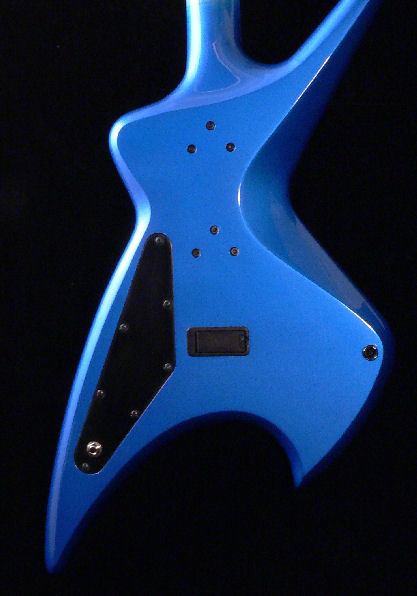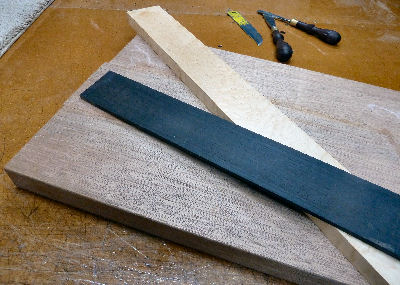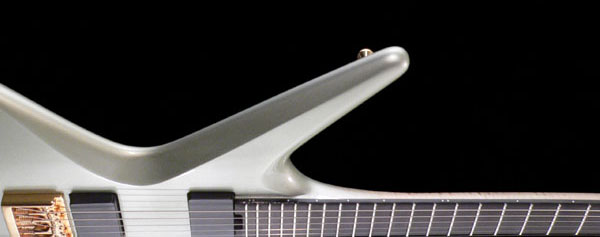American School of Lutherie
expert training for luthiers of all levelsHands-On Electric Guitar and Bass Making
Hands-On Acoustic Guitar Making
Contemporary Guitar Making
Setup, Fret Work & Basic Repair
HANDS-ON ELECTRIC GUITAR & BASS MAKING
HANDS-ON GUITAR & BASS MAKING
Electric Guitar & BassHands-on Electric and Bass classes is focused on the Fender design style.
Duration: 7 days
Class format: Each student creates
Tuition: $3500 plus materials
his or her own instrument as each
step is explained and demonstrated.
Enrollment is limited to two
participants. We work long hours,
Sunday through Saturday (seven
workshop days bracketed by two
travel days = five weekdays away
from your day job). Lutherie and
woodworking experience required. Please email or call us with any questions. By application.
The field of custom solid body electric guitar & bass making is flourishing with reative energy and innovation. Now is the best possible time to learn this craft. Join in the excitement and add your own ideas and passion to the mix.
OVERVIEW
During seven high-energy days you'll design and build a performance quality solid body guitar or bass while learning the skills used to create today's finest hand made instruments. You'll learn a versatile, efficient system for building both one-of-a-kind custom and standardized small shop production instruments, without investing in expensive specialized equipment. This system allows you unlimited creative freedom as well as total precision and control.
This is not a kit building class. You'll work from the raw materials to create your own unique professional quality electric guitar or bass. You'll learn the important qualities of the best solid body instrument woods and how to work with each of them for best results. After using all the hand tools and modest power tools of the trade, you'll know exactly what equipment you actually need to set up shop at home and what you can safely ignore.
WHAT YOU'LL LEARN
Design - learn to optimize every aspect of the instrument for tone, playability, ergonomics, visual beauty, and ease of construction
Materials - learn the visual, structural and tonal qualities of various electric guitar & bass woods
Hardware - learn the pros and cons of standard hardware components - their individual qualities, types, and styles - to be able to select the best parts for every custom guitar ot bass project
Electronics - learn to design custom tone control circuits, learn professional soldering, wiring and shielding techniques
Tools - learn to use all of the hand tools, power tools, and standard machine tools used to make electric guitars & basses
Woodworking skills - learn professional techniques for gluing, carving, routing, drilling, milling, sanding, staining, spraying, buffing, etc.
Jigs and fixtures - learn to create specialized, easily built devices to maximize your instruments' quality, precision and repeatability
Templates - learn to create your own precision router templates for body shape, pickup and neck pockets, rear tremolo and control cavities, etc.
Setting up shop - learn how to design the best layout for your own work space, how to install basic shop systems and purchase basic tooling on a budget
Bodies - learn best methods for gluing-up, dimensioning, cutting to shape, contouring, sculpting, drilling, routing, sanding, and finishing
Necks - learn best methods for laminating neck blanks, installing graphite rails and truss rods, tapering and shaping arms, shaping and drilling peg heads, creating and installing compound-radius fingerboards
Fitting neck to body - learn how to align and join neck to body at any precise angle, and how to blend neck into body seamlessly
Fret work - learn professional techniques for preparing, installing, leveling, dressing, shaping, and polishing frets for the most effortless playability
Assembly - learn how to install hardware and other components - pickups, bridge, strap buttons, shielding, pots, switches, and output jacks, plus knobs, pickguard, cover plates, etc - without scratching or otherwise marring the finished body and neck.
Setup - learn to fine-tune the nut, neck, bridge, strings, and pickups for balanced output, perfect intonation, and seamless playability.WHAT YOU'LL BUILD
You'll make a state-of-the-art electric guitar or bass based on the basic Fender platform. Your custom hand-made instrument will have top-of-the-line hardware and electronic components and will be wired for full-range tone control of your own design. This is a serious, professional level guitar or bass built to deliver whatever you ask of it and blow the socks off anyone within listening range. Every individual's ideal instrument is unique to his/her own personal taste and musical requirements. This 7-day intensive workshop is your opportunity to create your own personal guitar or bass with the features and qualities that work best for you.
Your design options - body shape, hardware, pickup types and combination, tone controls, switching, etc.
And your design constraints (Oh, no!) - non-laminated body face, inlays done later at home, oil finish here or spray finish at home.
Reality check: This is not a one-shot 'build-your-dream-guitar' experience. It is designed to provide a strong foundation for your continuing self-directed learning, which is assumed. In spite of working long hours and using very efficient building techniques, we
do run up against a limit of what can be accomplished in seven days without compromising the value of your learning experience. Our week-long timeframe allows neither laminating and carving of body face plates, inlaying fancy dragons, nor applying a full-on sprayed finish. Regarding finishing alone, the hours required for sealing, filling, masking, staining, practicing with the gun, spraying color coats, top coats, etc, plus the weeks required for the finish to cure - all this before final leveling, buffing, assembly and setup - are clearly beyond the scope of our time together. Be assured, we'll supply all the information and other resources you'll need to master on your own anything not addressed directly in class.
NOTE: All current Hands-on Electric Guitar & Bass Making classes are focused on the Fender style - in our case this simply means that the neck and body are in plane.
FENDER STYLE?
Virtually every solid body guitar is built on either one or a combination of two basic templates, defined early on by Fender's and Gibson's very different approaches to building solid body guitars.
Fender guitars & basses are designed to be made as efficiently as possible. Their interchangeable necks and bodies are made separately from flat plank stock, finished separately, and finally joined by simply bolting them together. A Fender style neck is parallel to the plane of its body and, as a result, Fender bridges are low to the body to optimize string action. The standard Fender neck is maple with an unbound fingerboard, its headstock extending parallel to the fingerboard. The Fender body is usually alder or ash, unbound and painted, with rounded edges and sculpted to fit the player's body. Its pickups and controls are mounted on a separate face-plate/pickguard.
Hand-made and other non-Fender guitars built along these lines might have set necks, fancy hardwood face veneers, control assemblies mounted from the rear, etc, but regardless of a Fender style guitar's individual shape and other details, its defining characteristic is its shallow flat profile; headstock and neck are parallel to the plane of the body. Besides the knowledge and skills to make more solid body instruments on your own, you'll return home with your own hand-crafted custom guitar or bass - electronics solidly installed, frets polished to a mirror finish, set up fine-tuned and strings perfectly intonated; ready for playing, performing, touring, or just showing off to your family and friends. Speaking of touring, your guitar will be designed for bullet-proof stability - a guitar that you can count on, that can take most anything you can you can throw at it. Unlike a Gibson, its peg head won't snap off if it falls over. Unlike a Fender, it won't hum or pick up stray radio waves on stage. Its signal won't buzz or crap out due to poor shielding or sloppy wiring, nor will its strings break mid-performance because of a poorly executed nut slot. A quality electric guitar or bass is not a fragile instrument and you'll be proud to have created such a solid, all-around performance-quality tone machine, your first time out.


